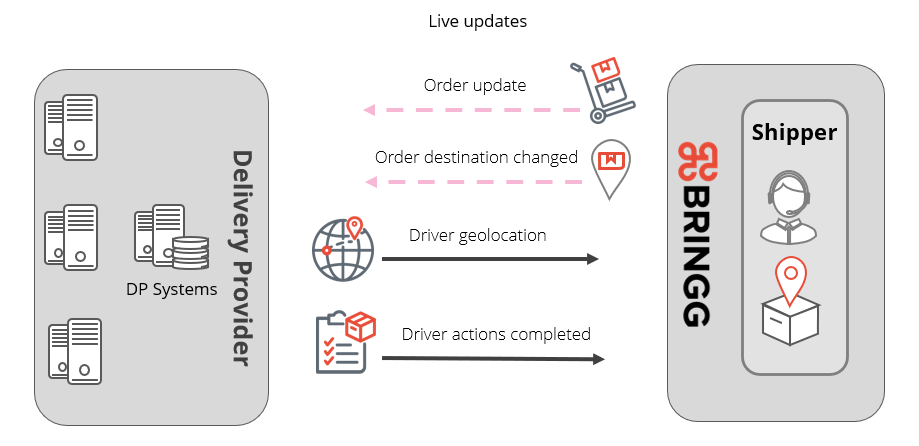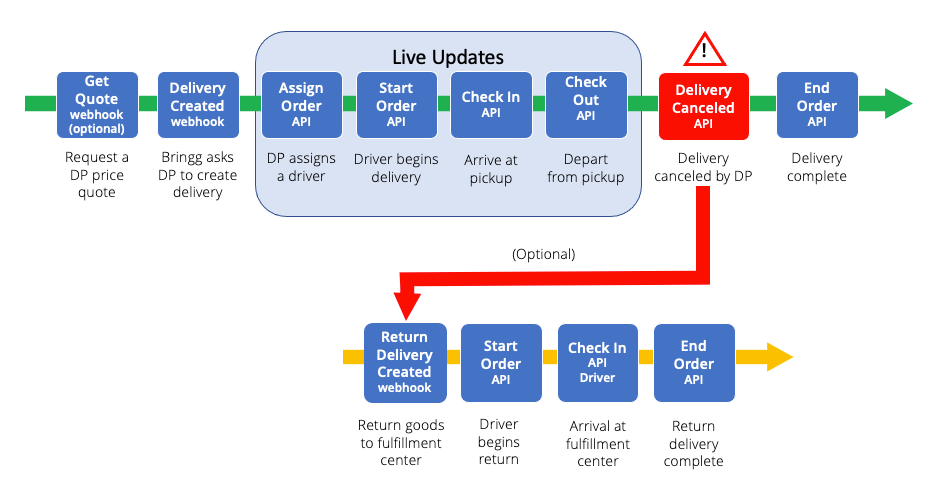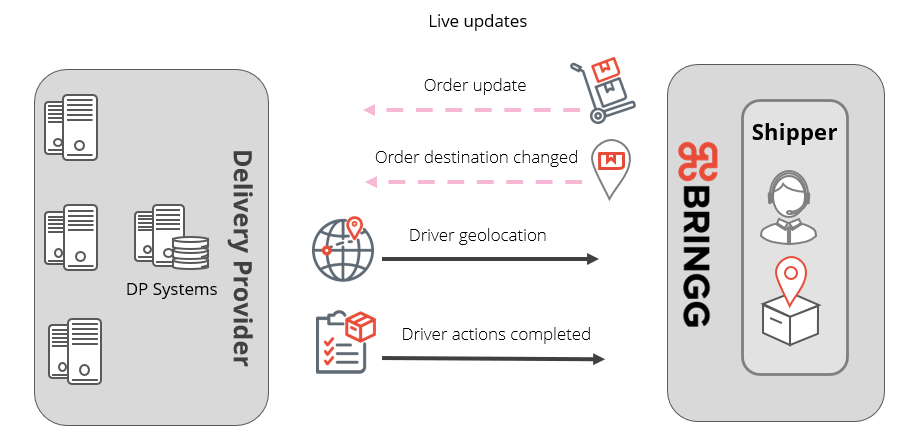As a carrier, you can grow your business by independently integrating with the Bringg Platform to gain access to more shippers who choose you to fulfill their orders.
Start by defining order flows that reflect each fulfillment scenario your company supports, including standard flows, white glove services like installation, or verification methods like taking a photo or obtaining a signature. Also define edge cases like canceled, or returned items.
Plan your integration working closely with your company's IT integrator who is responsible for the technical implementation on your end. You may choose to integrate first with Bringg alone, or in coordination with one or more contracted shippers. The process can take as little as a couple of weeks, but varies according to your company's configuration and the scope of implementation.
 Design the flow of information between you and a Bringg shipper
Design the flow of information between you and a Bringg shipper
Before You Begin
- Identify different types of order flows. Perhaps some items require assembly on site, or include repair services. An order could also include bulk pickup. Include edge case scenarios as well, like cancellations or returns. Each type requires its own end-to-end process.
- Identify the technical capabilities you support such as quotes, driver location updates, proof of delivery, multi-package shipment, and so on.
- Determine how much advanced notice you require to fulfill an order, and the service levels you have available such as planned or on demand deliveries.
- Verify your pricing policy in charging shippers.
- Define your service areas in terms of the maximum radius your drivers can travel to deliver goods and services.
- Finalize agreements with interested shippers so that you can tailor your integration to their fulfillment needs.
Procedure
Step 1: Join a kickoff meeting that Bringg initiates with you and your IT integrator, and perhaps a shipper interested in working with you.
The main purpose of this meeting is to align expectations and understand more in depth your company's capabilities and how they correlate with shippers' needs and with Bringg.
Step 2: Define your typical business flow of delivery requests, from the moment it arrives from a shipper until your drivers fulfill the order.
 Begin with a standard delivery flow
Begin with a standard delivery flow
An ideal order flow might begin with you responding to a carrier quote request. The quote tells Bringg about the price and when you can fulfill the delivery. Then Bringg informs you that the shipper accepted your quote and has created a delivery request that Bringg shares with you. You then assign a driver to an order. You can continue to notify Bringg as the driver arrives at pickup and dropoff locations and completes the delivery process.
You can tailor flows for different types of white glove services like installation or repairs, as well as different verification methods like taking a photo or obtaining a signature.
Step 3: Build robust plans for edge cases. For example, define the steps which a driver must perform if an item arrives damaged and the driver needs to return it to the store or fulfillment center.
 Create a cancelation and return flow
Create a cancelation and return flow
Step 4: List all possible updates you can send and receive while fulfilling an order, distinguishing those that are mandatory or optional.
Your IT integrator communicates data with Bringg through data transfer mechanisms called APIs and webhooks. The more information you transfer, the more transparency you have with your shippers, and the more they are likely to choose you as their partner.
For example, you can send a Start Order API to notify Bringg when your driver begins the delivery process.
 Track the flow of information between your company and Bringg
Track the flow of information between your company and Bringg
Step 5: Convert each step of the order flow into a high level conversation between systems in your company and the Bringg Platform.
When this happens... | Transfer this data... | Direction of flow |
|---|---|---|
New shipper registration | Bringg sends you the identification information of a shipper who registers to work with you. Your IT integrator can then access their credentials in the integration sandbox. | Bringg to carrier |
Shipper requests a quote | (Recommended) Send a quote response with your estimated delivery price and your availability to complete the order. The shipper may also request details like ETA, ability to fulfill green delivery, and so on. | Bringg to carrier |
Shipper sends order | Bringg notifies you that a shipper wants you to deliver goods, so you create a delivery in your system with an identification and the terms of the delivery that you quoted. | Bringg to carrier |
You assign a driver | Share any authorized identification information about the driver who receives the assignment or reassignment. The shipper passes this to consumers for better customer experience, added feeling of safety, and so on. This is also where you can add a cost to the order once you know who is delivering it. | carrier to Bringg |
Driver starts the delivery | Notify Bringg that the driver has begun the delivery process. Include the location, time, delivery price, and whether or not it is a green delivery. | carrier to Bringg |
Update driver location | (Recommended) Share the timestamp and exact geolocation of the driver. | carrier to Bringg |
Driver arrives | (Recommended) Share the timestamp and exact geolocation of the driver upon arrival at either the pickup or dropoff location. | carrier to Bringg |
Driver adds information | (Recommended) Update the order when the driver adds a note, signature, proof of delivery, or any other delivery documentation the driver collects. | carrier to Bringg |
Driver leaves | (Recommended) Share the timestamp and exact geolocation of the driver as they leave the pickup location. Upon leaving the dropoff location, use the Complete Order API instead. | carrier to Bringg |
Shipper cancels order | Bringg notifies you that the shipper canceled the order and includes a reason why, like if the customer decides to cancel it. This helps you know you can end a delivery immediately and avoid wasting time and resources. | Bringg to carrier |
You cancel order | Cancel a delivery, like if the customer is not home, or there are no available drivers. | carrier to Bringg |
You update order | (Optional) Update the scheduled pickup or delivery time, the time window, driver ETA, green delivery, delivery price, and so on. | carrier to Bringg |
Shipper updates order | The shipper makes changes to the address, goods, time window, or customer information. | Bringg to carrier |
Driver completes order | Send the timestamp, delivery price, order number, or geolocation of the driver when you complete the delivery. | carrier to Bringg |
Bringg creates return delivery | (Optional) The Shipper requests that your driver take the inventory item back to the fulfillment center, so it creates a new delivery with the same order id. | Bringg to carrier |
Driver arrives at or leaves bulk pickup location | (Optional) Do a bulk pickup of orders from a fulfillment center or other similar location and deliver them to your warehouse or store location. | carrier to Bringg |
Work with your IT integrator to define the event triggers for each update in every flow as the order moves from one stage of delivery to the next.
Step 6: Coordinate with your IT integrator to test and implement the updates between your system and Bringg, by using the Bringg Integrations Portal. Learn more.